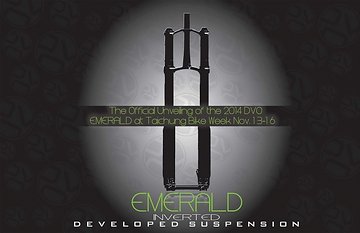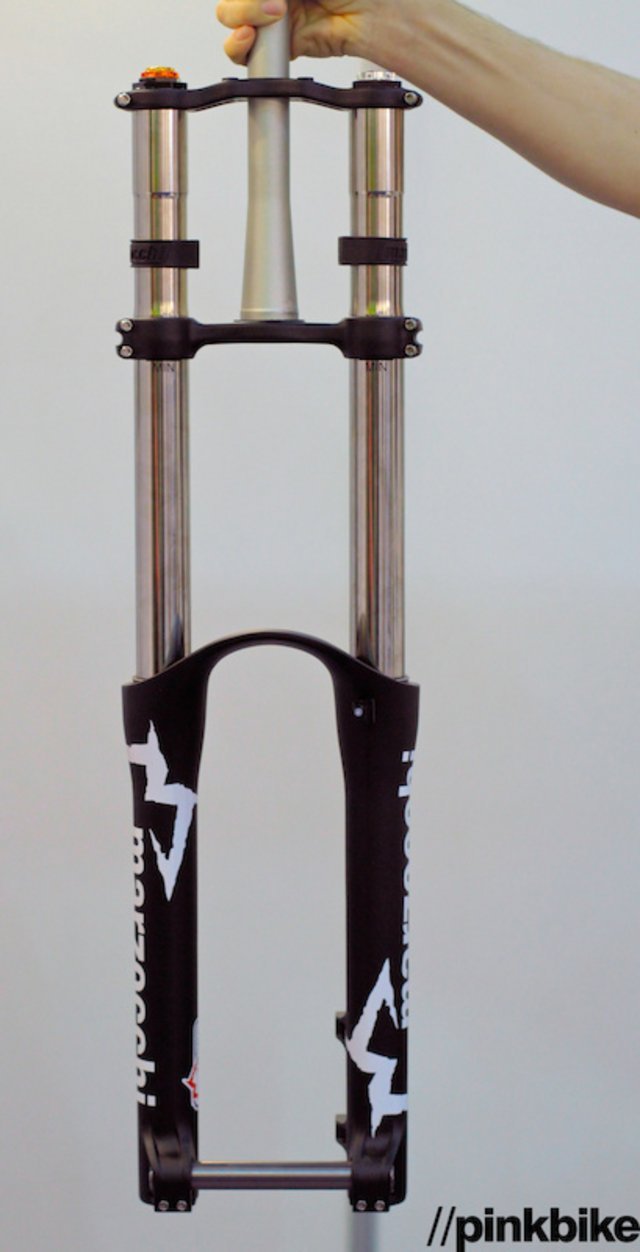Marzocchi 380 C2R2 Titanium
Although most wouldn't have guessed it, 2014 will mark a decade of the 888 in Marzocchi's lineup. The Italian's long-travel DH fork has evolved throughout the years, with a multitude of different variations to meet performance and price needs, but it was time for Marzocchi to start from scratch with a new design, which is exactly what they have done with the 380 C2R2 Titanium. Yes, it may look similar to its predecessor from a distance, yet a closer look will reveal an entirely new beast - about the only thing it has in common with the previous 888 is it being right-side-up. The 200mm travel fork utilizes a brand new 'Dynamic Bleed Cartridge', much lighter crowns, a fresh lower leg design that loses the 'M' arch yet gains rigidity, and added external damper adjustments in the form of both separate low and high-speed compression and rebound dials. It is also compatible with both 26'' and 650B wheel sizes.
380 C2R2 Titanium Details
⢠Intended use: DH racing
⢠Travel: 200mm
⢠Titanium coil spring
⢠38mm nickel treated stanchions
⢠Tapered or straight steerer
⢠New 'Dynamic Bleed Cartridge'
⢠Adjustments: separate low and high-speed compression, low and high-speed rebound
⢠Titanium clamp bolts stock
⢠Compatible with 650B wheels
⢠Production fork weight: 6.28lb
⢠Availability: September, 2013
⢠MSRP: TBA
Dynamic Bleed Cartridge
Previous 888s employed Marzocchi's longstanding open bath approach to damper design, with a sealed cartridge (
more recent 888 cartridges could be tuned, though) that
fed on the same oil that acted as lubrication within the fork. This layout made for exceptionally smooth performance due to there being enough oil to slosh about and lube the fork's bushings, although it couldn't meet how a closed or semi-closed damper performs when talking consistency because of that very same sloshing effect. Marzocchi says that their new Dynamic Bleed Cartridge is hybrid of the three versions cited above, although it certainly requires some internal trickery to make that happen. The DBC cartridge uses a "one-way seal" that allows oil to enter as required, but the clever bit is a spring-loaded piston that acts a compensator (
very similar to how an internal floating piston functions in a shock's piggyback) that keeps the cartridge full of oil without it hydraulically locking: the piston moves up to make room as the damper cartridge fills with oil, and also down in its travel to take up the lost displacement as oil rushes out. While it both sounds and is more complicated than Marzocchi's older open bath damper, the DBC system borrows technology that the Italian company is familiar with from using it within their motocross forks.
The DBC damper may be new to Marzocchi's lineup, but they are not straying away from their open approach to giving consumers the ability to remove and tune vital damper components. Looking for a change that can't be done via the external low and high-speed compression dials? The entire compression assembly can be removed from the top of the fork to allow the garage tuners and pro mechanics to make alterations to the mid-speed compression circuit, and shim stack assemblies that will make the job easier will likely be available from Marzocchi.

Damper Adjustments
While Marzocchi has never been a stranger to a good amount of adjustments on their high-end downhill forks, the new 380 C2R2 Titanium brings further external tuning options into the picture with the addition of a high-speed rebound dial. Compression adjustments can be made via concentric dials atop the right fork leg: the inner dial controls low-speed settings and the outer high-speed, although it should be noted that the cosmetic appearance of both may change by the time the fork reaches production this coming September. The same goes for both the low and high-speed rebound knobs at the opposite end of the fork. The fork shown here is still in the prototype stage but the dials had very defined detent to each turn.

New Axle Design
A revised axle is found at the bottom of the 380 C2R2 Titanium, with replaceable aluminum barrel inserts acting as home for the four titanium pinch bolts, and a keyed shape to the left side that nests into lowers. This latter change means that only one hex key is required to install and remove the axle, unlike the older design that demanded one for each side. The axle itself also now features an internal taper to it, making it thin in the middle where material isn't needed and helping to shave 30 grams compared to last year's design.

New Crowns and Lowers
Rather than use the same crowns as on their 888 forks (
the 38mm stanchions are the same size after all), Marzocchi has gone ahead with a new design that looks slimmer, weighs less, and according to Marzocchi, increases rigidity. Post-forging machining is used to create a hollow lower crown - 888 lower crowns are solid - that adds up to 40 grams of weight loss, and Marzocchi says that the clamping bolts have now been moved to the side of the crowns to improve turning
clearance and better distribute stress. Many of Marzocchi's forks have long used an arch with an 'M' shape to them that, while aesthetically pleasing to some, never really played a functional role. The big M is no longer, though, with a slimmer and much more practical shape to the arch. The new lowers contribute to another 100 grams of weight loss over the 888 RC3 EVO V.2 Titanium, adding up to a 170 gram difference between the crowns and lowers.

Moto C2R Shock
While the ROCO will still be in the lineup for 2014 in the shape of three air models and a TST R version, Marzocchi's new Moto C2R shock will be taking center stage as their top tier DH shock. The Moto C2R follows the same principle as the new 380 C2R2 Titanium fork shown above, with Marzocchi aiming for it to be one of the lightest long-stroke coil-sprung shocks on the market. To this end, the shock body itself has been machined down to only what is needed, while the 14mm shaft (
the ROCO uses a 12mm shaft) and shock eyelet have actually been manufactured as a single aluminum unit.
Moto C2R Shock Details
⢠Intended use: downhill
⢠Adjustments: separate low and high-speed compression, low-speed rebound
⢠Access to the high-speed rebound shim stack for tuning
⢠One-piece shaft and eyelet assembly
⢠Weight: 369 grams (
9.5'' x 3'', w/o spring or hardware)
⢠Availability: TBA
⢠MSRP: TBA

Damper Adjustments
Separate adjustment dials for low and high-speed compression tuning are located on the piggyback bridge, with both closely resembling the dials found on the 380 C2R2 Titanium fork in shape and color in an effort to reduce confusion. The red dial at the other end of the shock controls low-speed rebound and, unlike the ROCO, it doesn't need to be removed in order to slide the shock's coil spring off.


















